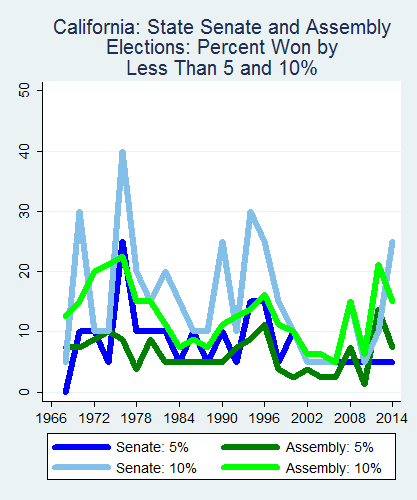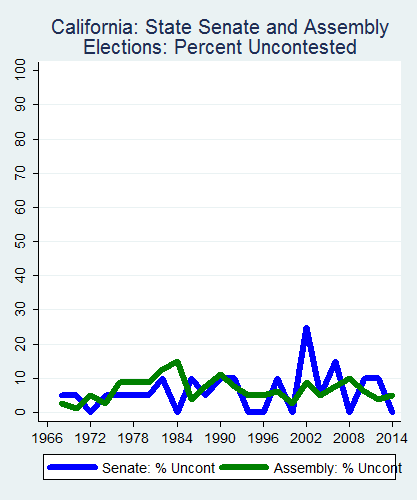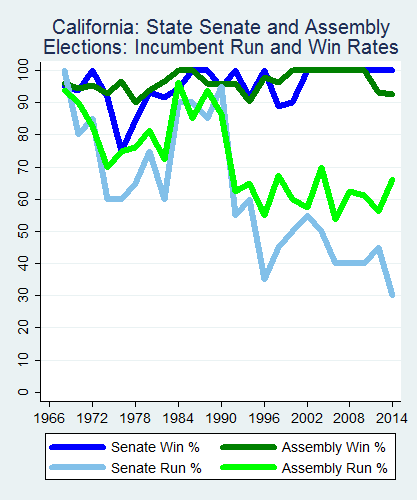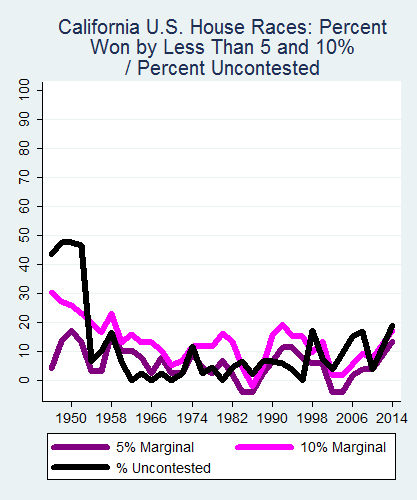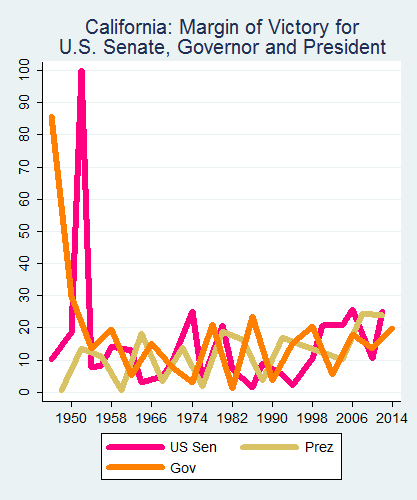Electoral competitiveness in California, 1912-2014
state legislatures |
|---|
Published in April 2015
The 2014 national election continued the decline in U.S. electoral competitiveness that has occurred since 1972. The decline of electoral competitiveness that has been seen on the national stage, has also been seen in states. Even California, which had a historically low percentage of uncontested races from 1968 to 2014, saw a decline in the percentage of uncontested U.S. House elections, from 43.5 percent to 18.9 percent.
This page contains electoral competitiveness information at various levels of government in this state up to 2014. For more recent information about state legislative competitiveness nationwide, click here.
The data presented below are part of a larger project on electoral competitiveness, the full report is available in the table to the right. The images below illustrate the changes in the competitiveness of elections in California from 1912 through 2014. The data used to generate these graphs is available in the tables below those images.
Background
Since 1972, electoral competitiveness has tended to decrease across the United States. During that time, people who are members of the same political party have become more likely to live in the same area as one another than in the past. Nationally, the rate at which incumbents won reelection is also close to an all-time high. However, this does not have to do with incumbents deriving more advantages from holding office than before. It is because they are more likely to be in safe districts for their party. In contrast to the high incumbency reelection rate, the rate at which incumbents run for reelection has gone down over time.
Competitiveness is declining. On the national level, the percentage of state legislative elections won by 5 percent or less was nearly the lowest in the 1972 to 2014 period. In an absolute sense, the incidence of such elections was very low. Only 4.9 percent of U.S. residents in districts with elections saw their election won by 5 percent or less. Similarly, more Americans lived in areas with uncontested elections than ever before in the time period studied: 36.7 percent. State legislative primaries were often found to be won by wide margins or not contested at all. The rate at which incumbents won reelection is also close to an all-time high. However, this does not have to do with incumbents deriving more advantages from holding office than before. It is because they are more likely to be in safe districts for their party. In contrast to the high incumbency reelection rate, the rate at which incumbents run for reelection has gone down over time.
Competitiveness in elections in California
Table explanation
The columns in the tables below for both state senates and state houses are as follow:
- Seats: number of seats in the state legislative chamber.
- Percent Seats Up: percent of seats in the state legislative chamber that are up in a particular year for the November election.
- Percent Won By Dem: the percent of seats in the state legislature that were won by a Democrat.
- Percent Unusable: percent of seats for the state legislative chamber that weren’t usable to compute whether a race was marginal or not for this chamber in this year because of missing data. This column usually says “0.”
- Percent with 5% margin: percent of seats for a state chamber in a year that were won by 5% or less.
- Percent with 10% margin: percent of seats for a state chamber in a year that were won by 10% or less.
- Percent Unusable Other: percent of seats that have missing data that prevent the computation of whether an incumbent won or lost, whether an incumbent ran or not, or whether a race was uncontested. This column usually says “0.”
- Percent Uncontested: percent of races in a chamber that are uncontested.
- Percent Incumbent Win: percent of incumbents who ran for a state chamber in a particular year who won.
- Percent With Incumbent: number of incumbents running for reelection for a state-chamber in one year, divided by the number of seats that are up for election for that state-chamber, multiplied by 100.
The columns for the “Up ballot” tab are as follows:
- U.S. House Seats: number of U.S. House Seats that a state was apportioned in the year in question.
- Percent Not Usable: percent of U.S. House Seats in the state and year that aren’t usable to compute marginality or contestation, because of something unusual about the race.
- Percent With 5% Margin: percent of U.S. House races in the state and year that were won by 5% or less.
- Percent With 10% Margin: percent of U.S. House races in the state and year that were won by 10% or less.
- Percent Uncontested: percent of U.S. House races that were uncontested in the state and year.
- U.S. Senate 1 Margin: difference between the percent obtained by the winner of the U.S. Senate election with the U.S. Senate candidate receiving the second most votes.
- U.S. Senate 2 Margin: This is only recorded when a second election to the U.S. Senate was held because of a Senator not completing their term. For such elections, this is the difference between the percent obtained by the winner of the U.S. Senate election with the U.S. Senate candidate receiving the second most votes.
- President margin: difference between the percent of votes obtained by the presidential candidate receiving the most votes in a state minus the percent of votes obtained by the presidential candidate receiving the second most votes in a state.
- Governor margin: difference between the percent obtained by the winner of the gubernatorial election in a state with the gubernatorial candidate receiving the second most votes.
State Senate
| State Senate competitiveness, California | ||||||||||||
|---|---|---|---|---|---|---|---|---|---|---|---|---|
| Year | Seats | % Seats up | % Won by Dem | % Unusable | % With 5% margin | % With 10% margin | % Unusuable other | % Uncontested | % Incumbent win | % With incumbent | % of Dem inc winning | % of Repub inc winning |
| 1968 | 40 | 50 | 50 | 0 | 0 | 5 | 0 | 5 | 95 | 100 | 100 | 90 |
| 1970 | 40 | 50 | 60 | 0 | 10 | 30 | 0 | 5 | 93.8 | 80 | 100 | 85.7 |
| 1972 | 40 | 50 | 40 | 0 | 10 | 10 | 0 | 0 | 100 | 85 | 100 | 100 |
| 1974 | 40 | 50 | 85 | 0 | 5 | 10 | 0 | 5 | 91.7 | 60 | 100 | 66.7 |
| 1976 | 40 | 50 | 45 | 0 | 25 | 40 | 0 | 5 | 75 | 60 | 66.7 | 83.3 |
| 1978 | 40 | 50 | 80 | 0 | 10 | 20 | 0 | 5 | 84.6 | 65 | 84.6 | |
| 1980 | 40 | 50 | 45 | 0 | 10 | 15 | 0 | 5 | 93.3 | 75 | 87.5 | 100 |
| 1982 | 40 | 50 | 80 | 0 | 10 | 20 | 0 | 10 | 91.7 | 60 | 100 | 66.7 |
| 1984 | 40 | 50 | 45 | 0 | 5 | 15 | 0 | 0 | 94.4 | 90 | 100 | 100 |
| 1986 | 40 | 50 | 70 | 0 | 10 | 10 | 0 | 10 | 100 | 90 | 100 | 100 |
| 1988 | 40 | 50 | 50 | 0 | 5 | 10 | 0 | 5 | 100 | 85 | 100 | 100 |
| 1990 | 40 | 50 | 75 | 0 | 10 | 25 | 0 | 10 | 94.7 | 95 | 100 | 80 |
| 1992 | 40 | 50 | 45 | 0 | 5 | 10 | 0 | 10 | 100 | 55 | 100 | 100 |
| 1994 | 40 | 50 | 65 | 0 | 15 | 30 | 0 | 0 | 91.7 | 60 | 88.9 | 100 |
| 1996 | 40 | 50 | 50 | 0 | 15 | 25 | 0 | 0 | 100 | 35 | 100 | 100 |
| 1998 | 40 | 50 | 75 | 0 | 5 | 15 | 0 | 10 | 88.9 | 45 | 100 | 75 |
| 2000 | 40 | 50 | 55 | 0 | 10 | 10 | 0 | 0 | 90 | 50 | 100 | 80 |
| 2002 | 40 | 50 | 70 | 0 | 5 | 5 | 0 | 25 | 100 | 55 | 100 | 100 |
| 2004 | 40 | 50 | 55 | 0 | 5 | 5 | 0 | 5 | 100 | 50 | 100 | 100 |
| 2006 | 40 | 50 | 70 | 0 | 5 | 5 | 0 | 15 | 100 | 40 | 100 | 100 |
| 2008 | 40 | 50 | 55 | 0 | 5 | 15 | 0 | 0 | 100 | 40 | 100 | 100 |
| 2010 | 40 | 50 | 70 | 0 | 5 | 5 | 0 | 10 | 100 | 40 | 100 | 100 |
| 2012 | 40 | 50 | 75 | 0 | 5 | 10 | 0 | 10 | 100 | 45 | 100 | 100 |
| 2014 | 40 | 50 | 55 | 0 | 5 | 25 | 0 | 0 | 100 | 30 | 100 | 100 |
State House
| State House competitiveness, California | ||||||||||||
|---|---|---|---|---|---|---|---|---|---|---|---|---|
| Year | Seats | % Seats up | % Won by Dem | % Unusable | % With 5% margin | % With 10% margin | % Unusuable other | % Uncontested | % Incumbent win | % With incumbent | % of Dem inc winning | % of Repub inc winning |
| 1968 | 80 | 100 | 48.8 | 0 | 7.5 | 12.5 | 0 | 2.5 | 96 | 93.8 | 92.3 | 100 |
| 1970 | 80 | 100 | 53.8 | 0 | 7.5 | 15 | 0 | 1.3 | 94.4 | 90 | 100 | 88.6 |
| 1972 | 80 | 100 | 63.8 | 0 | 8.8 | 20 | 0 | 5 | 95.5 | 82.5 | 100 | 89.3 |
| 1974 | 80 | 100 | 68.8 | 0 | 10 | 21.3 | 0 | 2.5 | 92.9 | 70 | 94.3 | 90.5 |
| 1976 | 80 | 100 | 71.3 | 0 | 8.8 | 22.5 | 0 | 8.8 | 96.7 | 75 | 100 | 88.9 |
| 1978 | 80 | 100 | 62.5 | 0 | 3.8 | 15 | 0 | 8.8 | 90.2 | 76.3 | 87.2 | 100 |
| 1980 | 80 | 100 | 60 | 0 | 8.8 | 15 | 0 | 8.8 | 93.8 | 81.3 | 95.1 | 91.7 |
| 1982 | 80 | 100 | 60 | 0 | 5 | 11.3 | 0 | 12.5 | 96.6 | 72.5 | 94.1 | 100 |
| 1984 | 80 | 100 | 58.8 | 0 | 5 | 7.5 | 0 | 15 | 100 | 96.3 | 100 | 100 |
| 1986 | 80 | 100 | 55 | 0 | 5 | 8.8 | 0 | 3.8 | 100 | 85 | 100 | 100 |
| 1988 | 80 | 100 | 58.8 | 0 | 5 | 7.5 | 0 | 7.5 | 96 | 93.8 | 100 | 90.9 |
| 1990 | 80 | 100 | 60 | 0 | 5 | 11.3 | 0 | 11.3 | 95.7 | 86.3 | 97.6 | 92.9 |
| 1992 | 80 | 100 | 60 | 0 | 7.5 | 12.5 | 0 | 7.5 | 96 | 62.5 | 100 | 88.2 |
| 1994 | 80 | 100 | 48.8 | 0 | 8.8 | 13.8 | 0 | 5 | 90.4 | 65 | 84.4 | 100 |
| 1996 | 80 | 100 | 53.8 | 0 | 11.3 | 16.3 | 0 | 5 | 97.7 | 55 | 100 | 96 |
| 1998 | 80 | 100 | 60 | 0 | 3.8 | 11.3 | 0 | 6.3 | 96.3 | 67.5 | 100 | 91.3 |
| 2000 | 80 | 100 | 62.5 | 0 | 2.5 | 10 | 0 | 2.5 | 100 | 60 | 100 | 100 |
| 2002 | 80 | 100 | 60 | 0 | 3.8 | 6.3 | 0 | 8.8 | 100 | 57.5 | 100 | 100 |
| 2004 | 80 | 100 | 60 | 0 | 2.5 | 6.3 | 0 | 5 | 100 | 70 | 100 | 100 |
| 2006 | 80 | 100 | 60 | 0 | 2.5 | 5 | 0 | 7.5 | 100 | 53.8 | 100 | 100 |
| 2008 | 80 | 100 | 63.8 | 0 | 7.5 | 15 | 0 | 10 | 100 | 62.5 | 100 | 100 |
| 2010 | 80 | 100 | 65 | 0 | 1.3 | 6.3 | 0 | 6.3 | 100 | 61.3 | 100 | 100 |
| 2012 | 80 | 100 | 68.8 | 0 | 13.8 | 21.3 | 0 | 3.8 | 93.3 | 56.3 | 93.3 | 93.3 |
| 2014 | 80 | 100 | 65 | 0 | 7.5 | 15 | 0 | 5 | 92.5 | 66.3 | 89.2 | 100 |
Up ballot
| Up ballot competitiveness, California | |||||||||
|---|---|---|---|---|---|---|---|---|---|
| Year | U.S. House Seats | % Not usable | % With 5% margin | % With 10% margin | % Uncontested | U.S. Senate 1 margin | U.S. Senate 2 margin | President margin | Governor margin |
| 1912 | 0 | ||||||||
| 1916 | 0.4 | ||||||||
| 1920 | 46.3 | ||||||||
| 1924 | 26.7 | ||||||||
| 1928 | 30.8 | ||||||||
| 1932 | 21.9 | ||||||||
| 1936 | 35.7 | ||||||||
| 1938 | 8.6 | ||||||||
| 1940 | 16.3 | ||||||||
| 1942 | 15.5 | ||||||||
| 1944 | 4.6 | 13.6 | |||||||
| 1946 | 23 | 0 | 4.3 | 30.4 | 43.5 | 10.1 | 85.7 | ||
| 1948 | 23 | 4.3 | 13.6 | 27.3 | 47.8 | 0.5 | |||
| 1950 | 23 | 0 | 17.4 | 26.1 | 47.8 | 18.5 | 29.7 | ||
| 1952 | 30 | 0 | 13.3 | 23.3 | 46.7 | 100 | 13.7 | ||
| 1954 | 30 | 0 | 3.3 | 20 | 6.7 | 7.8 | 13.7 | ||
| 1956 | 30 | 0 | 3.3 | 16.7 | 10 | 8.4 | 11.2 | ||
| 1958 | 30 | 0 | 16.7 | 23.3 | 16.7 | 14.1 | 19.6 | ||
| 1960 | 30 | 0 | 10 | 13.3 | 6.7 | 0.5 | |||
| 1962 | 38 | 0 | 10.5 | 15.8 | 0 | 12.9 | 5.1 | ||
| 1964 | 38 | 0 | 7.9 | 13.2 | 2.6 | 3.1 | 18.3 | ||
| 1966 | 38 | 0 | 2.6 | 13.2 | 0 | 15.3 | |||
| 1968 | 38 | 0 | 7.9 | 10.5 | 2.6 | 5 | 3.3 | ||
| 1970 | 38 | 0 | 2.6 | 5.3 | 0 | 9.7 | 7.9 | ||
| 1972 | 43 | 0 | 2.3 | 7 | 2.3 | 13.9 | |||
| 1974 | 43 | 0 | 9.3 | 11.6 | 11.6 | 25.1 | 2.9 | ||
| 1976 | 43 | 0 | 4.7 | 11.6 | 2.3 | 3.4 | 1.8 | ||
| 1978 | 43 | 0 | 2.3 | 11.6 | 4.7 | 21.1 | |||
| 1980 | 43 | 0 | 7 | 16.3 | 0 | 20.7 | 18.9 | ||
| 1982 | 45 | 2.2 | 2.3 | 13.6 | 4.4 | 7 | 1.2 | ||
| 1984 | 45 | 0 | 0 | 4.4 | 6.7 | 16.4 | |||
| 1986 | 45 | 0 | 0 | 0 | 2.2 | 1.5 | 23.7 | ||
| 1988 | 45 | 0 | 2.2 | 4.4 | 6.7 | 9.1 | 3.6 | ||
| 1990 | 45 | 0 | 6.7 | 15.6 | 6.7 | 3.6 | |||
| 1992 | 52 | 0 | 11.5 | 19.2 | 5.8 | 5.4 | 17.7 | 17 | |
| 1994 | 52 | 0 | 11.5 | 15.4 | 3.8 | 2.1 | 15.2 | ||
| 1996 | 52 | 0 | 7.7 | 15.4 | 0 | 14.4 | |||
| 1998 | 52 | 0 | 5.8 | 9.6 | 17.3 | 10.5 | 20.3 | ||
| 2000 | 52 | 0 | 5.8 | 13.5 | 7.7 | 20.8 | 12.4 | ||
| 2002 | 53 | 0 | 0 | 1.9 | 3.8 | 5.4 | |||
| 2004 | 53 | 0 | 0 | 1.9 | 9.4 | 20.8 | 10.1 | ||
| 2006 | 53 | 0 | 1.9 | 5.7 | 15.1 | 25.9 | 17.9 | ||
| 2008 | 53 | 0 | 3.8 | 9.4 | 17 | 24.6 | |||
| 2010 | 53 | 0 | 3.8 | 7.5 | 3.8 | 10.6 | 13.6 | ||
| 2012 | 53 | 17 | 4.5 | 15.9 | 7.5 | 25 | 23.7 | ||
| 2014 | 53 | 1.9 | 13.5 | 17.3 | 18.9 | 19.9 | |||
| ||||||||||||||||||||||||||||||||||



